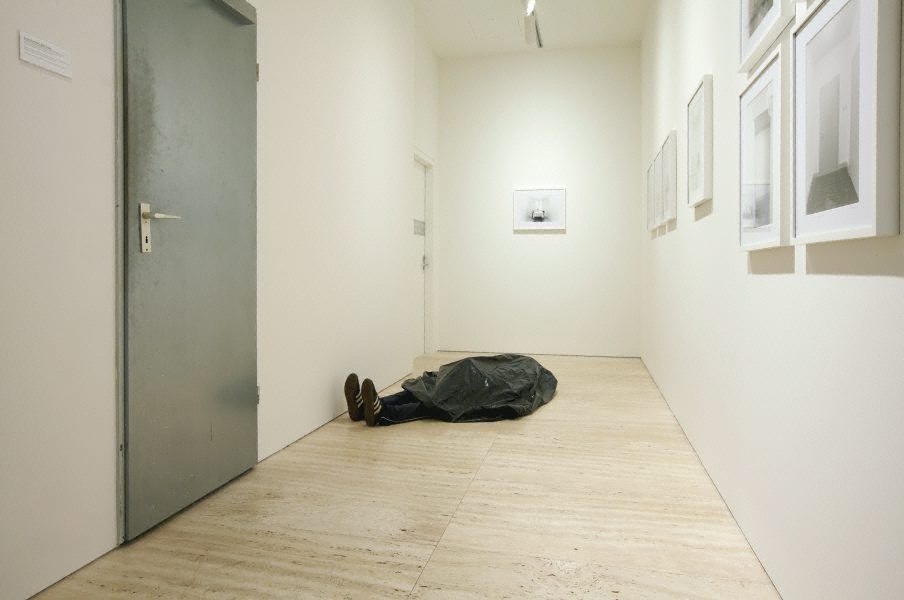It was during this lecture that I first heard of Gregor Schneider. He is a very interesting character and his art concepts are equally as intriguing.
Gregor Schneider
Short Bio
Gregor Schneider (1969, Rheydt-Germany)
Lives and works in Mönchengladbach, Rheydt, Germany.
Gregor Schneider is one of the most famous artists of his generation. He studied at the Kunstakademie in Düsseldorf and Münster, the University of Fine Arts in Hamburg and he has worked as guest professor in several universities around the world.
His works reflect his deep fears and traumas, however, in dealing with these issues he hopes to help us to reflect upon and overcome our nightmares. He became world famous when we won the Golden Lion at the Venice Biennale in 2001 with an installation of his childhood home, Totes Haus U R. The place was transformed into a maze with fake partitions, lead-lined rooms and a kitchen encrusted with mould.
Last year Schneider became embroiled in controversy after saying he wanted to create a space in a museum in which people could die. His argument was that society’s horror of death was so acute that we prefer to ignore it, leaving people to die in the clinical impersonality of a hospital rather than somewhere beautiful.

Gregor Schneider – 400 Meter Black Dead End, 2006 – 8 Photographs – 43x53cm
From 1985 Gregor Schneider (D, 1969) is continuously working on Haus ur in Rheydt. Since this time, the house is constantly rebuilt, hallways are made, double walls are constructed and windows are added, creating a labyrinth of sinister spaces. Haus ur is Schneider’s most famous work and was completely reconstructed in 2001 at the Venice Biennale, exhibited at the German Pavilion. Entitled ‘Der Deutsche Beitrag’ Schneider delivered with this mental labyrinth a sharp ironic commentary.
The series of 8 photo’s 400 Meter Black Dead End has been made in Naples. The color photographs show eight positions at night from the street entering in a dark basement eventually resulting in a full black surface.
The first images starts at just a few meters distance from the house. The title indicates that hundreds of meters darkness will follow, after being surrounded by the complete darkness of the cellar. Again this work can be read as a sharp commentary on the famous black square made by Malevich: the work was an important prelude to a century Modernism. This black square placed against the sun first appeared in 1913 in a design for the opera Victory over the Sun.
The series of 8 photo’s 400 Meter Black Dead End has been made in Naples. The color photographs show eight positions at night from the street entering in a dark basement eventually resulting in a full black surface.
The first images starts at just a few meters distance from the house. The title indicates that hundreds of meters darkness will follow, after being surrounded by the complete darkness of the cellar. Again this work can be read as a sharp commentary on the famous black square made by Malevich: the work was an important prelude to a century Modernism. This black square placed against the sun first appeared in 1913 in a design for the opera Victory over the Sun.
http://theridder.com/exhibitions/cassinicruiselll/gregor-schneider/

Basement cellar house, 1985-2012, 11 x 4 m
Extra Info:
Dark eerie spaces, dimly lit rooms and narrow passages leading to dead ends make up this immersive installation, which contrasts starkly with the bright gallery around it.
The artwork is a partial reconstruction of 'Totes Haus U R (Dead house)', a residential apartment block in Rheydt, Germany, which Schneider has transformed in an ongoing artistic project. Since 1985, he has been compulsively reconfiguring this building into labyrinth-like, uncanny architectural environments. In 1996, he began to recreate rooms from the house in exhibition spaces around the world, including this work which is based on the cellar. No longer a home, it has become a place of confinement, mystery and dislocation.

Dead house, 2001, gelatin silver photograph, 27.0 x 39.0 cm sight; 42.4 x 52.3 x 3.5 cm frame

Shadow window, 1996, 192.0 x 109.0 x 6.0 cm
No comments:
Post a Comment